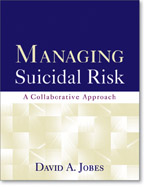
The Aeschi Working Group
MEETING THE SUICIDAL PERSON
The therapeutic approach to the suicidal patient
CAMS
| FUTURE EVENTS |
| NEW: www.assip.ch |
| THE BOOK: BUILDING A THERAPEUTIC ALLIANCE WITH THE SUICIDAL PATIENT |
| THE GUIDELINES FOR CLINICIANS |
| PAST EVENTS |
| 1st Aeschi Conference |
| 2nd Aeschi Conference |
| 3rd Aeschi Conference |
| 4th Aeschi Conference |
| 5th Aeschi Conference |
| 6th Aeschi Conference |
| 7th Aeschi Conference (Aeschi West) |
| 8th Aeschi Conference (Aeschi 8) |
| 9th Aeschi Conference (Aeschi 9) |
| 10th Aeschi Conference (Aeschi 10) |
| PROBLEMS
IN CLINICAL PRACTICE |
| The usual clinical practice |
| Clinicians' attitudes |
| Patients' dissatisfaction |
| Non-attendance in aftercare |
| Treatment failures |
| A PATIENT-ORIENTED APPROACH |
| New perspectives |
| Patients' narratives |
| Patients' inner experiences |
| Joining the patient |
| CAMS |
| The
Narrative Action Theoretical (NAT) approach |
| Mental Pain |
| INFORMATIONS |
| The Aeschi Group |
| Publications |
| Links |
| Hotel Aeschi Park |
| Destination Aeschi |
| Download main text as pdf here |
| Download Guidelines for Clinicians as pdf here |
| Home |
Brief Overview of CAMS
The Collaborative Assessment and Management of Suicidality, otherwise known as CAMS (Jobes, 2000; Jobes, Luoma, Jacoby, & Mann, 1998), is one of only a handful of suicide-specific manualized assessment and treatment approaches for clinical care of suicidal patients. There are many novel aspects to this empirically developed protocol. For example, CAMS uses an evolved version of the Suicide Status Form - SSF (Jobes, Jacoby, Cimbolic, & Hustead, 1997) to guide a collaborative phenomenological assessment of the patientís suicidality. The SSF used in CAMS has been expanded to include both quantitative measures as well qualitative measures that are used to reliably assess the patientís suicidality relying on their own words. This approach asserts that the patient's multidimensional experience of suicidality is the assessment gold standard that both the clinician and patient must thoroughly understand before effective treatment can occur. In this regard, our model defies traditional and reductionistic "medical-model" approaches that emphasize the expert-doctor searching for diagnostic symptoms and developing a treatment plan based only on the patient's DSM-IV diagnosis. Indeed, the collaborative use of the SSF leads to the emergence of underlying suicidal constructs that can be used to directly inform and shape the treatment plan. The patient thus becomes a co-author of his or her own clinical treatment plan, which increases compliance and strengthens the clinical alliance therein.
T_Model.pdf
Traditional (medical model) assessment of suicide risk versus Collaborative
Assessment and Management of Suicidality (CAMS)
Jobes, D. A. (2000). Collaborating to prevent suicide: A clinical-research
perspective. Suicide and Life-Threatening Behavior, 30, 8-17.
Jobes, D. A., Jacoby, A. M., Cimbolic, P., & Hustead, L. A. T. (1997).
The assessment and treatment of suicidal clients in a university counseling
center. Journal of Counseling Psychology, 44, 368-377.
Jobes, D. A., Luoma, J. B., Jacoby, A. M., & Mann, R. E. (1998). Manual
for the collaborative assessment and management of suicidality (CAMS).
Unpublished manuscript.
Managing Suicidal Risk
A Collaborative Approach
David A. Jobes, Foreword by Edwin S. Shneidman
Publication Date: August 2006, Guilford Press
This clinical manual offers essential tools and
guidance for therapists of any orientation faced with the complex challenges
of assessing and treating a suicidal patient. In a large, ready-to-photocopy
format, the book provides step-by-step instructions and reproducible forms
for evaluating suicidal risk, developing a suicide-specific outpatient
treatment plan, and tracking clinical progress and outcomes using documentation
that can help to reduce the risk of malpractice liability. In addition
to providing a flexible structure for assessment and intervention, The
Collaborative Assessment and Management of Suicidality (CAMS) approach
is designed to strengthen the therapeutic alliance and increase patient
motivation. Highly readable and user-friendly, the volume builds on 15
years of empirically oriented clinical research.

http://www.guilford.com/cgi-bin/cartscript.cgi?page=pr/jobes.htm&dir=pp/paci&cart_id=